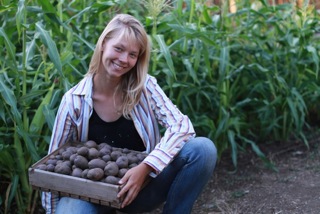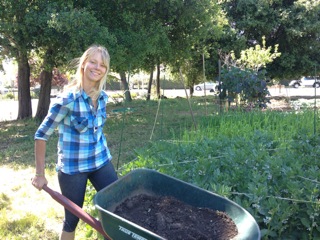Zuzanna Drozdz, Common Ground Garden Manager
I came to work in small-scale agriculture by a circuitous route. Although I started college with a deep interest in biology, I was seduced by the dynamic field of Product Design. As I pursued my degree at Stanford University, I felt that the design-thinking methodology was both empowering and humbling in a deeply satisfying way, but I floundered as I sought a context to apply it, that would be both meaningful in the long term and enjoyable on a daily basis. As I learned more about the extent and consequences of environmental degradation—driven by consumer societies in the developed world and exploding populations in the developing world—I felt a growing responsibility and desire to apply my skills to preventive and ultimately restorative environmental solutions. Just as my feelings of helplessness and eco-anxiety were becoming stifling, I fell down a rabbit hole that led me to the restoring potential of sustainable, small-scale agriculture using the GROW BIOINTENSIVE (GB) method. On Earth Day in 2009, I heard John Jeavons speak about the extent of global soil erosion and degradation, the dire consequences of continuing current destructive practices, as well as the potential of using natural systems to rebuild arable soil. I was profoundly moved by the scope of the challenge as well as the beauty of the solution, AND that there was something we could do—that I could do—to replenish this precious resource. I had never thought of being a farmer before that day, but when I wrote to John that evening to express my interest in supporting his work and Ecology Action, I knew without a doubt that I had to learn to grow soil and food using the GB method and to share that knowledge and practice with others. The opportunity to work with Ecology Action and to manage the Common Ground Garden came through a serendipitous series of events. Almost a year after first learning about GB, I sat down with my college advisor, Bill Burnett, for advice on finding and developing a design project relating to small-scale agriculture for the culminating design class of my degree. Incredibly, when Bill was still studying Product Design, he had designed two tools: a pedal-powered thresher and a welded digging tool called a U-bar, both in collaboration with John and Ecology Action. With this new-found connection and inspiration, I sought to find a design project that I could work on with Ecology Action. In the process, I visited Ecology Action’s research garden as well as the mini-farm at Golden Rule. I was convinced of the effectiveness of the GB method and enamored with the lifestyle of the gardeners who lived it. When the opportunity to initially work in and ultimately to manage the Common Ground Garden in Palo Alto arose, I was thrilled to have found a way to learn, live, and teach GB.
Depending on the time of year when you stop by the garden, you might find preschool students with their magnifying lenses identifying garden friends (worms) and foes (slugs and snails), elementary students preparing the soil and tracking the sun for their sunflower house design, “middle schoolers” harvesting, threshing and winnowing wheat, and high school students learning about the place of quinoa and amaranth in ancient Aztec and Incan culture. We find that when students participate in growing and preparing organic grains, fruits and vegetables, they are enthusiastic about eating them. Observing our students’ wonder grow as they see their seedlings germinate or watching them pull up carrots for the first time, is all the motivation I need to get ready for a new round of transplanting carrots on 3-inch centers! Working at the Common Ground Garden has proved a fine rabbit hole to land in and has fulfilled my search for a context for design thinking, as well as for a restorative environmental solution.
top | Newsletter Home | Article Index | Archive
|



 The garden is a half-acre piece of land where we have put in more than 2,800 sq ft of biologically intensive garden beds and compost piles. The garden seeks to transform our students' and visitors' relationship to food, and to motivate them to grow their own food through biologically intensive, more sustainable gardening. The unlikely proximity of six schools that collectively serve 3000 students—all of which are within a 15-minute walk of the garden—has led us to develop classes and programming with a vision of educating our students to become “good eaters.” We strive to give students experiences and lessons that enable them to develop a firm understanding of how to make food choices that positively impact their bodies, the environment, and the people who produce their food. We find that completing the cycle from seed to bread (or grain bowl) can be very profound for students, who think bread manifests in a plastic bag in the supermarket. In addition to working directly with students, we seek to develop and publish curricula firmly rooted in GB, as well as state standards of education.
The garden is a half-acre piece of land where we have put in more than 2,800 sq ft of biologically intensive garden beds and compost piles. The garden seeks to transform our students' and visitors' relationship to food, and to motivate them to grow their own food through biologically intensive, more sustainable gardening. The unlikely proximity of six schools that collectively serve 3000 students—all of which are within a 15-minute walk of the garden—has led us to develop classes and programming with a vision of educating our students to become “good eaters.” We strive to give students experiences and lessons that enable them to develop a firm understanding of how to make food choices that positively impact their bodies, the environment, and the people who produce their food. We find that completing the cycle from seed to bread (or grain bowl) can be very profound for students, who think bread manifests in a plastic bag in the supermarket. In addition to working directly with students, we seek to develop and publish curricula firmly rooted in GB, as well as state standards of education.